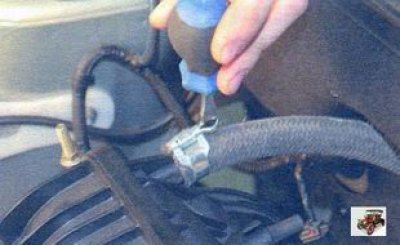
Attention! Regularly check the brake fluid level in the master cylinder reservoir. When the plug is installed, the level should be at the lower edge of the brake reservoir neck, and when the plug is removed, it should be near the mark «MAX» on the brake housing.
Car manufacturers recommend changing all brake fluid in the brake system after 3 years or 45,000 km (whichever comes first).
Some drivers disregard this advice because the brake fluid in the brake reservoir seems clean enough to them, and completely in vain. The fact is that brake fluid is very hygroscopic: it absorbs moisture from the air, and this moisture over time not only destroys the surfaces of brake cylinders, pipelines and, as a result, leads to premature failure of brake system components, but also significantly reduces the boiling point brake fluid. Normal boiling point of brake fluid «Neva» - 190°С, «Tom» - 210°С, «Dew» - 260°С. The front wheel disc brakes become very hot during frequent heavy braking, and if the water content is high, the brake fluid may boil, which usually leads to brake failure. If you have problems with the brakes, bleed the brake system on the car (see «Bleeding the brake system»). If bleeding the brakes on the car does not give the desired result, it is necessary to carefully check the entire brake system, as described below (see «Checking the brake system»).
Bleeding the brake system
If the brake pedal has become «soft», and with several successive clicks it becomes «harder», which means that air has entered the hydraulic brake actuator.
To remove air from the brake system, it is necessary to bleed the brakes. The procedure for bleeding the brakes on a car is quite simple, but it is more convenient to carry it out with an assistant.
A detailed description of bleeding the brake system can be found in sec. «Brake system» (see «Bleeding the brake system»).
Checking the brake system
1. The reason for the loss of braking efficiency may be the unsatisfactory operation of the vacuum booster. For an express check of the vacuum booster, press the brake pedal several times with the engine off to remove the vacuum in the vacuum booster, and then, while holding the brake pedal, start the engine. If the brake pedal drops slightly after starting the engine, the vacuum brake booster is OK.

2. If the brake pedal remains stationary, check the integrity and reliability of the connection of the vacuum booster hose to the fitting on the engine intake pipe...

3....and with a non-return valve. Replace or repair defective hose. If the hose is good, the vacuum booster needs to be replaced (see «Removal and installation of the vacuum amplifier of brakes»).
If braking is accompanied by a beating and pulsation of the brake pedal, you should first check the condition of the front brake discs.
4. Having established the car on a jack, remove a forward wheel and examine a brake disk. The thickness of the brake disc must be at least 17.8 mm, the surface of the disc must be even and smooth on both sides. If the surface of the disc is covered with rust in places, which usually happens after a long parking of the car with the brakes not dried, try cleaning the working surface with a fine emery cloth. If this procedure does not help, you will have to give the brake discs for grinding or replace them with new ones.

5. Check up mobility of the piston of the brake mechanism. To do this, use two screwdrivers to try to move the brake caliper from its place. If the brake caliper cannot be moved, then the piston in the brake cylinder is stuck.
